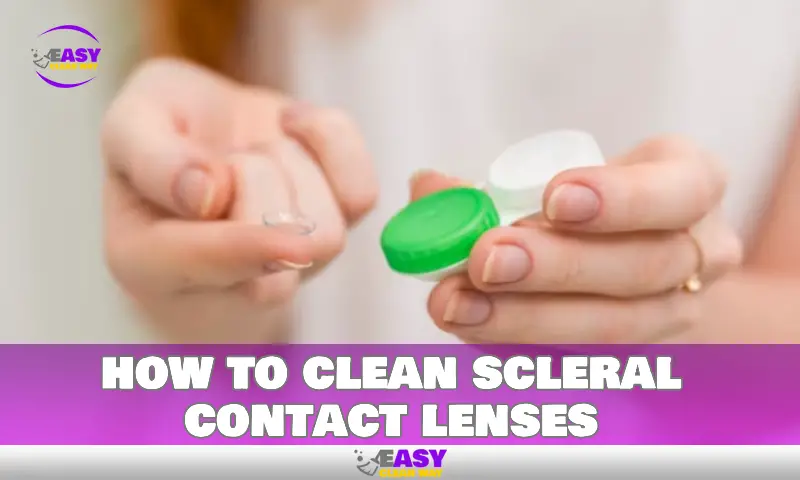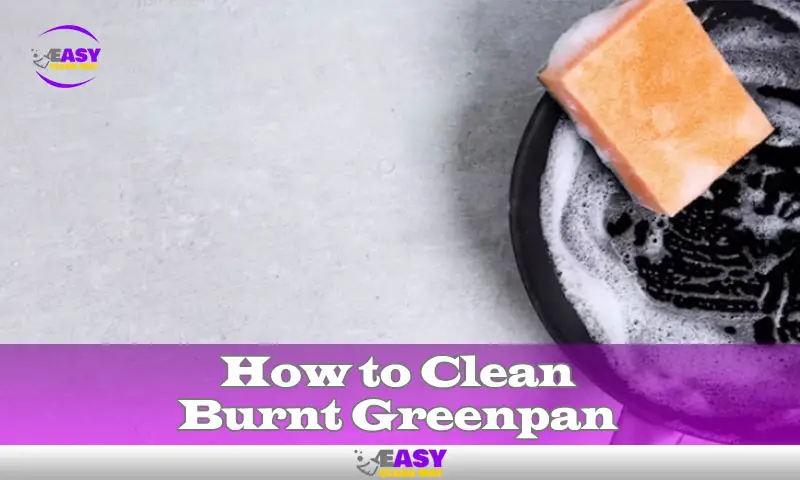To clean scleral contact lenses, start by washing your hands thoroughly with soap and water, then rinse the lenses with a saline solution. Next, use a multipurpose lens solution to rub the lenses gently for about 20 seconds.
Rinse the lenses again with the saline solution and store them in a clean case filled with fresh solution. Repeat this cleaning routine every day. Additionally, it’s important to regularly clean and disinfect the lens case using a solution and let it air dry.
Avoid using tap water or saliva to clean the lenses. As an alternative, you can also use a hydrogen peroxide solution, following the instructions provided. Regular cleaning and disinfection are crucial to maintaining the durability and clarity of scleral contact lenses.
Understanding Scleral Contact Lenses
Scleral contact lenses are a type of specialty contact lens that offers several unique features and advantages for people with certain vision needs. Unlike traditional soft contact lenses that sit on the cornea, scleral lenses cover a larger portion of the eye, including the white sclera.
This design provides several benefits for those with corneal irregularities or certain eye conditions. Here’s what you need to know about scleral contact lenses:
- Scleral lenses are larger in diameter than conventional contact lenses, typically ranging from 14 to 24 millimeters. The larger size allows them to rest on the sclera, which enhances stability and comfort.
- The lenses hold a pool of liquid between the lens and the cornea, creating a cushioning effect that promotes better corneal hydration and gas exchange. This is especially beneficial for individuals with dry eyes or corneal irregularities.
- Scleral lenses provide vision correction for a range of conditions, including astigmatism, keratoconus, irregular corneas, and post-surgical complications. They help improve visual acuity by providing a smooth and consistent optical surface.
- The design of scleral lenses also makes them an excellent option for individuals who have had difficulty with other types of contact lenses. The added stability and customization options of scleral lenses can overcome the challenges posed by irregular corneas, resulting in improved visual clarity and comfort.
- Scleral lenses require specialized fitting and care. An eye care professional with expertise in managing scleral lenses can ensure the lenses fit properly, provide optimum vision correction, and maintain long-term eye health.
Advantages Of Using Scleral Lenses For Vision Correction
Scleral lenses offer numerous advantages for individuals seeking vision correction beyond what traditional soft contact lenses can provide. Here are some key benefits of using scleral lenses:
- Superior comfort: The larger size of scleral lenses ensures that they do not make direct contact with the sensitive cornea, leading to enhanced comfort, especially for those with dry eyes. The liquid cushion between the lens and the eye also prevents irritation and promotes long-lasting comfort throughout the day.
- Stable fit: Scleral lenses provide a more secure fit due to their larger size and resting position on the sclera. This stability ensures that the lenses do not shift or move around in the eyes, providing consistently clear and stable vision.
- Customized design: Each scleral lens is individually designed and custom-fit for the unique measurements of your eyes. This personalized approach ensures the best possible fit, comfort, and vision correction for your specific needs.
- Improved visual acuity: Scleral lenses can correct a wide range of vision issues, including astigmatism and corneal irregularities. By providing a smooth and consistent optical surface, these lenses help to enhance visual acuity and improve the overall quality of vision.
- Protection and moisture for the cornea: The liquid reservoir between the lens and the cornea acts as a protective barrier, shielding the cornea from debris, dust, and other irritants. Additionally, this reservoir provides a constant source of moisture, helping to combat dryness and discomfort.
Scleral contact lenses offer unique advantages and enhanced vision correction for individuals with certain eye conditions or corneal irregularities. Their larger size, customized design, comfort, and stability make them an excellent option for those seeking optimal vision and long-term eye health.
Consulting with an experienced eye care professional is crucial to ensure proper fitting and care for scleral lenses.
Step-By-Step Guide To Cleaning Scleral Contact Lenses

Cleaning your scleral contact lenses is an essential part of maintaining good eye health and ensuring optimal vision. By following a step-by-step guide, you can efficiently clean your lenses and keep them in top shape. Let’s dive into the process and learn how to clean your scleral contact lenses effectively.
Gathering Necessary Supplies And Creating A Clean Workspace
To ensure a successful cleaning routine, it’s important to gather all the necessary supplies and create a clean workspace. Here’s what you’ll need:
- Contact lens cleaning solution
- Saline solution or sterile saline
- Contact lens case
- Contact lens tweezers (optional)
- A clean, lint-free towel or tissue
Once you have all the supplies ready, find a clean and well-lit area to work in. It’s crucial to have a clutter-free workspace to minimize the risk of contamination.
Removing The Lenses Safely And Handling Them With Care
Before you start cleaning your scleral lenses, you need to remove them safely and handle them with care. Follow these steps:
- Wash your hands thoroughly with soap and water.
- Dry your hands with a clean towel or let them air dry.
- Fill a small bowl with saline solution or sterile saline.
- Lean over a clean surface, such as a bathroom countertop or a towel, to catch any dropped lenses.
- Look upwards and gently pull down your lower eyelid with one hand.
- Using your other hand, apply slight pressure to your eyeball near the lower edge of the lens.
- Blink or move your eyeball slightly to loosen the lens from your eye.
- Use the tips of your fingers or contact lens tweezers (if preferred) to gently remove the lens from your eye.
Rinsing The Lenses With A Recommended Solution To Remove Debris And Potential Irritants
Once you’ve safely removed your scleral lenses, it’s time to rinse them to remove any debris and potential irritants. Follow these steps:
- Rinse your lenses with a recommended contact lens cleaning solution.
- Hold each lens in the palm of your hand and pour a few drops of the solution onto the lens.
- Gently rub the lens between your fingers in a circular motion for about 20-30 seconds.
- Make sure to cover the entire surface of the lens, including the edges.
- Rinse the lens thoroughly with saline solution or sterile saline to remove any cleaning solution residue.
Using A Specialized Cleaning Solution To Thoroughly Clean The Lenses
To ensure thorough cleaning of your scleral lenses, it’s recommended to use a specialized cleaning solution. Here’s how to proceed:
- Fill your lens case with the recommended cleaning solution.
- Place one lens in each corresponding compartment of the case.
- Close the case securely, ensuring no solution spills out.
- Leave the lenses in the cleaning solution for the recommended amount of time, usually overnight.
- This solution will help break down any protein or lipid deposits that may have accumulated on the lenses.
- It’s important to follow the manufacturer’s instructions regarding the soaking time.
Disinfecting The Lenses Using A Recommended Method
Disinfecting your lenses is crucial to eliminate any harmful bacteria or microorganisms that may be present. Follow these steps to ensure proper disinfection:
- After the recommended soaking time, empty the cleaning solution from the lens case.
- Rinse the case thoroughly with saline solution or sterile saline.
- Fill the case with a fresh disinfecting solution, making sure it covers the lenses completely.
- Place the lenses in the designated compartments of the case.
- Seal the case securely to avoid any leakage.
- Leave the lenses to soak in the disinfecting solution for the recommended period.
- It’s important to adhere to the manufacturer’s instructions to ensure effective disinfection.
Storing The Lenses Properly To Maintain Their Shape And Cleanliness
Proper storage is essential to maintaining the shape and cleanliness of your scleral lenses. Follow these steps:
- Empty the disinfecting solution from the lens case and rinse it with sterile saline.
- Place the lenses in the designated compartments of the case.
- Fill the case with fresh saline solution or sterile saline, ensuring the lenses are fully submerged.
- Close the case securely to prevent the lenses from drying out.
- Store the lens case in a clean, dry place at room temperature.
- Avoid storing the lenses in extreme temperatures or direct sunlight.
By following this step-by-step guide, you can confidently clean your scleral contact lenses and enjoy clear vision while maintaining excellent eye health. Remember to always follow the manufacturer’s instructions and consult your eye care professional if you have any concerns or questions.
Best Practices For Daily Lens Care
Establishing A Routine For Cleaning And Caring For Scleral Contact Lenses
When it comes to maintaining the longevity and clarity of your scleral contact lenses, establishing a proper cleaning routine is crucial. Here are some best practices to keep in mind:
- Begin by washing your hands thoroughly with mild, fragrance-free soap and drying them with a lint-free towel before handling your lenses.
- Follow the instructions provided by your eye care professional for cleaning solutions. Avoid using tap water or homemade solutions, as they can introduce harmful microorganisms to your lenses.
- Create a cleaning station by organizing all the necessary supplies within reach. This includes a designated container for holding the lenses, a disinfecting solution, and a preservative-free saline solution.
- Remove the lenses from your eyes and inspect them for any visible debris or deposits. Rinse them gently with the saline solution to remove any loose particles.
- Fill the lens container halfway with the disinfecting solution, ensuring the lenses are fully submerged. Give them time to soak for the recommended amount of time that your eye care professional has advised.
- After disinfecting, use the preservative-free saline solution to rinse the lenses thoroughly, ensuring all traces of the disinfecting solution are removed.
- Store the lenses in a clean lens case filled with fresh, preservative-free saline solution. Avoid using tap water or saliva as storage solutions.
- Clean and disinfect your lens case daily to prevent the buildup of bacteria or fungi. Rinse it with a fresh, sterile solution and let it air dry completely before reusing.
- Replace your lens case every three months to maintain hygiene and prevent contamination.
Remember, adhering to this routine diligently will help keep your scleral contact lenses clear, comfortable, and safe for your eyes.
Tips For Avoiding Common Mistakes That Can Lead To Lens Damage Or Eye Infection
To ensure the longevity of your scleral contact lenses and prevent eye infections, it’s essential to steer clear of common mistakes. Here’s what you should avoid:
- Never use tap water or homemade solutions for rinsing or storing your lenses. They may contain harmful microorganisms that can cause eye infections.
- Avoid using oil-based creams, lotions, or makeup around your eyes, as they can contaminate your lenses. Opt for water-based alternatives instead.
- Don’t wear your lenses while swimming or taking a shower, as they can come into contact with waterborne pathogens.
- Don’t expose your lenses to extreme heat or direct sunlight. Store them in a cool, dry place away from any sources of heat or intense light.
- Avoid rubbing your lenses vigorously when cleaning them, as this can cause scratches or tears. Use gentle motions and specialized cleaning solutions recommended by your eye care professional.
- Don’t wear your lenses beyond the recommended wearing time. Follow your eye care professional’s recommendations to prevent eye irritation, dryness, and potential complications.
- Avoid sharing your lenses with others, as this can lead to the transmission of bacteria, viruses, or other harmful pathogens.
- Don’t skip your regular eye exams. Routine check-ups with your eye care professional are essential for monitoring the health of your eyes and ensuring the proper fit and prescription of your lenses.
Understanding The Signs Of Lens Deterioration And When To Replace Them
Regularly monitoring the condition of your scleral contact lenses is vital for maintaining healthy eyes and optimal vision. Here are some signs that indicate lens deterioration and the need for replacement:
- If you experience persistent redness, discomfort, or excessive dryness while wearing your lenses, it may be a sign of lens deterioration or a poor fit. Schedule an appointment with your eye care professional to have your lenses evaluated.
- Any visible damage, such as scratches, cracks, or warping, warrants immediate replacement of your lenses. Damaged lenses can irritate your eyes and affect your vision.
- If your lenses become cloudy, or hazy, or develop an opaque film, it indicates a buildup of deposits or protein. Attempting to clean such lenses may be ineffective, so contact your eye care professional for advice.
- Changes in the fit or centration of your lenses can occur over time, leading to discomfort and reduced visual acuity. If you notice any shifts in lens position or stability, consult your eye care professional for an evaluation.
- Regular follow-ups with your eye care professional will help monitor any changes in your eye health or prescription, indicating the need for lens replacement.
- Remember, for optimum vision, comfort, and eye health, you must replace your lenses as your eye care professional advises.
Proper Lens Storage And Maintenance to Extend Their Lifespan
Proper storage and maintenance of your scleral contact lenses can significantly extend their lifespan and ensure your eye health. Here are some tips to keep in mind:
- Store your lenses in a dedicated lens case specifically designed for scleral lenses. Avoid using generic lens cases that may not provide adequate protection from moisture.
- Fill the lens case with fresh, preservative-free saline solution, ensuring the lenses are fully submerged. Avoid overfilling the case, as it may cause spills or inadequate hydration of the lenses.
- Replace the saline solution in your lens case daily to prevent the growth of bacteria, fungi, or other microorganisms. Completely empty and rinse the case with a fresh solution before refilling.
- Keep your lens case closed when not in use to prevent contamination. Avoid leaving it open or exposed to dust, debris, or airborne particles.
- Rinse your lens case thoroughly with fresh saline solution and let it air dry after each use. Avoid using tap water or wiping it with towels, as they may introduce unwanted particles or residues.
- If your eye care professional advises using enzymatic cleaning tablets, use a lens case that is compatible with them. Follow the instructions provided to ensure proper lens cleaning and protein removal.
- Avoid using expired or outdated saline solutions, cleaning solutions, or lens conditioners. Always check the expiration dates on the packaging and discard any expired products.
- Store your lenses and lens case in a clean, dust-free environment away from direct sunlight, heat sources, or extreme temperatures.
- Regularly replace your lens case every three months to maintain cleanliness, prevent contamination, and ensure proper lens storage.
By following these proper storage and maintenance practices, you can help prolong the lifespan of your scleral contact lenses while ensuring optimal eye health and vision.
Additional Tips For Maintaining Healthy Eyes

Taking care of your eye health doesn’t end with cleaning your scleral contact lenses. There are several other factors to consider in order to maintain optimal eye health. By incorporating these additional tips into your routine, you can reduce the risk of eye infections, manage eye discomfort, protect your eyes from environmental factors, and promote overall eye well-being.
Importance Of Regular Eye Exams And Consultations With An Eye Care Professional
To ensure your eyes are in good health, it is crucial to schedule regular eye exams and consultations with an eye care professional. Here are the key points to remember:
- Regular eye exams allow your eye care professional to detect any potential issues or changes in your eye health early on.
- Eye exams can uncover conditions such as glaucoma, cataracts, or macular degeneration that may not have noticeable symptoms in the early stages.
- Your eye care professional can prescribe the appropriate vision correction if needed, ensuring optimal visual acuity.
- These exams are especially important if you wear scleral contact lenses, as they can ensure the lenses are fitting correctly and not causing any damage to your eyes.
Hygiene Practices To Minimize The Risk Of Eye Infections
Maintaining proper hygiene practices is essential to minimizing the risk of eye infections. Here are some important points to remember:
- Always wash your hands thoroughly with soap and water before handling your contact lenses.
- As advised by your eye care specialist, use the recommended cleaning and disinfection procedures for your scleral contact lenses.
- Avoid using tap water or saliva to clean or rinse your lenses, as they can introduce harmful bacteria to your eyes.
- Replace your lens case regularly, and keep it clean by rinsing it with contact lens solution after each use.
- Avoid sleeping or swimming with your lenses on to reduce the risk of eye infections.
Recognizing And Managing Symptoms Of Eye Irritation Or Discomfort
Being able to recognize and manage symptoms of eye irritation or discomfort is crucial for maintaining good eye health. Here’s what you need to know:
- If you experience redness, itching, burning, or excessive tearing, remove your contact lenses and consult your eye care professional.
- Avoid rubbing your eyes if you feel any discomfort, as this can worsen irritation and potentially scratch your cornea.
- Applying a warm compress can offer temporary relief for dry or irritated eyes.
- Use artificial tears or lubricating eye drops to alleviate dryness or discomfort caused by wearing contact lenses for extended periods.
Protecting Your Eyes From Environmental Factors Such As Uv Rays And Dryness
Protecting your eyes from environmental factors is essential for maintaining healthy vision. Consider these key points:
- Wear sunglasses that provide adequate UV protection to shield your eyes from harmful ultraviolet rays.
- Invest in wraparound sunglasses or eyeglasses to provide additional protection from wind, dust, and debris.
- Use a humidifier in dry environments to prevent dryness and irritation of the eyes.
- Give your eyes regular breaks during extended periods of screen time to reduce eye strain and dryness.
Incorporating A Healthy Lifestyle To Promote Optimal Eye Health
Adopting a healthy lifestyle can significantly contribute to optimal eye health. Take note of these important factors:
- Maintain a well-balanced diet rich in fruits, vegetables, and omega-3 fatty acids, as they can help reduce the risk of certain eye conditions.
- Stay hydrated to keep your eyes moisturized and prevent dryness.
- Practice regular exercise to improve blood circulation, which benefits your overall eye health.
- Get plenty of sleep to allow your eyes to rest and rejuvenate.
By following these additional tips and incorporating them into your daily routine, you can maintain healthy eyes and enjoy clear vision for years to come. Remember, in addition to cleaning your scleral contact lenses, regular eye exams, hygiene practices, symptom recognition, environmental protection, and a healthy lifestyle are all vital aspects of maintaining optimal eye health.
FAQ
How Often Do I Need To Clean My Scleral Contact Lenses?
It is recommended to clean your scleral contact lenses every day, before and after each use.
What Is The Best Way To Clean Scleral Contact Lenses?
The best way to clean scleral contact lenses is by using a preservative-free saline solution or a lens cleaning solution specifically designed for scleral lenses.
Can I Clean My Scleral Contact Lenses With Tap Water?
No, it is not recommended to clean scleral contact lenses with tap water, as it can contain impurities and microbes that may harm your eyes. Use only recommended cleaning solutions.
Conclusion
Taking proper care of your scleral contact lenses is essential for maintaining good eye health and getting the most out of your lenses. By following the recommended cleaning steps, you can ensure that your lenses stay clean, comfortable, and free from any potential contaminants.
Remember to always wash your hands thoroughly before handling your lenses and use the recommended cleaning solution to disinfect them. It’s important to adhere to the cleaning instructions provided by your eye care professional and avoid using any products that are not specifically designed for cleaning scleral lenses.
Regularly cleaning and storing your lenses in a clean case will also help prevent any bacterial or fungal growth. By making cleaning and care a part of your routine, you can enjoy clear vision and healthy eyes while wearing your scleral contact lenses.
Hey there! I’m Alton Smith, your Clean Expert blogger. I’m on a quest to help you conquer chaos and embrace the joys of a tidy life.





